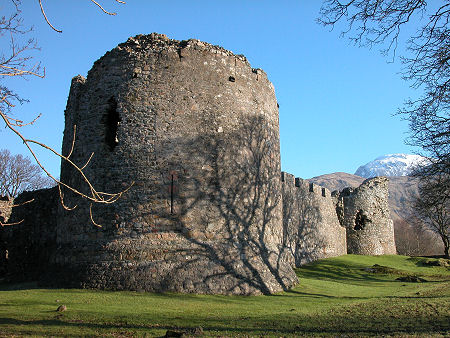 Inverlochy Castle, with Ben Nevis in the Background |
James Graham, 1st Marquess of Montrose lived from 1612 to 21 May 1650. He can be viewed in various lights. To some he was a man who backed both sides in the key conflicts of the day to further his own ambitions. Perhaps more charitably he can be viewed as a pragmatist who sought to avoid the state being dominated by the power of the church, shifting his own ground as the threat of that happening appeared stronger from first one side, then the other. The wider picture in Scotland at the time is set out in our Historical Timeline.
In 1638 King Charles I tried to impose an Anglican pattern of worship under the authority of Bishops on the mainly Presbyterian Scottish church. The result was the National Covenant, in effect a petition signed by Scots of all classes opposed to these changes.
On 21 November 1638 the General Assembly of the Church of Scotland began a month-long meeting in Glasgow despite the efforts of the King's Lord High Commissioner in Scotland, the Marquis of Hamilton, to dissolve it. By continuing with the meeting, the Assembly members effectively declared themselves as rebels against the King. This led to open warfare between Covenanters and Royalists.
In the First Bishops' War that followed, Montrose commanded the Covenanter forces in the main Royalist strongholds around Aberdeen, which he captured, along with the leader of the Royalist faction, the Marquess of Huntly. On 18 June 1639, Charles arrived with an English army at Berwick-upon-Tweed but when confronted with a much larger Scots army he agreed a truce, the Pacification of Berwick.
The Second Bishops' War broke out in August 1640. By now Montrose had come to view Archibald Campbell, the 1st Marquess of Argyll, and the main force behind the Presbyterian Covenanters, as a larger threat to his own view of the way Scotland should be governed than the King. So although Montrose fought for the Scots against the King in the Second Bishops' War he was afterwards arrested for conspiracy against Argyll and imprisoned in Edinburgh Castle in June 1641. However, after the King agreed to abolish his Scottish bishops, his supporters in Scotland, now including Montrose, were released.
Once the English Civil War was under way, Montrose asked Charles to let him mount a supporting campaign in Scotland. Charles declined until Scotland ended its neutrality by sending an army in support of Parliament in 1644. With very limited resources and some support from the Irish, Montrose then mounted a spectacular and brilliant campaign that marked him out as one of the great military commanders of his or parhaps any other age. This included victories over Covenanters at Aberdeen; over the Campbells at Inverlochy; and over well formed and disciplined opposing armies at Auldearn, Alford and Kilsyth. After the Battle of Kilsyth on 15 August 1645, Montrose found himself to be the effective ruler of Scotland on behalf of Charles I, who appointed him Lord-Lieutenant and Captain-General of Scotland.
Montrose summoned a parliament to meet at Glasgow on 20 October 1645, at which he intended to forge a Scotland that was both loyal to the king and free of bishops. But Charles I had been defeated at the Battle of Naesby on 14 June 1645, and Montrose hurried south to support him. He was ambushed at the Battle of Philliphaugh by General Leslie on 12 September, and although Montrose escaped he was unable to raise a further army and departed for Norway a year later.
In 1649 Montrose was re-appointed Lord-Lieutenant of Scotland by Charles II. In March 1650 he landed in Orkney then moved south to try to raise an army of Highlanders. He failed, and on 27 April 1650 his small force was defeated at the Battle of Carbisdale.
Montrose escaped across country and found himself, two days later, at Ardvreck Castle, where he sought sanctuary with Neil Macleod of Assynt. Neil was away, and his wife, Christine, tricked Montrose into the castle dungeon and sent for troops of the Covenanter Government. Montrose was taken to Edinburgh, where he was executed on 21 May 1650. Charles II, now planning to return via Scotland, could probably have saved Montrose, but instead chose to deny any part in the invasion so as not to place an impediment in his own path.


